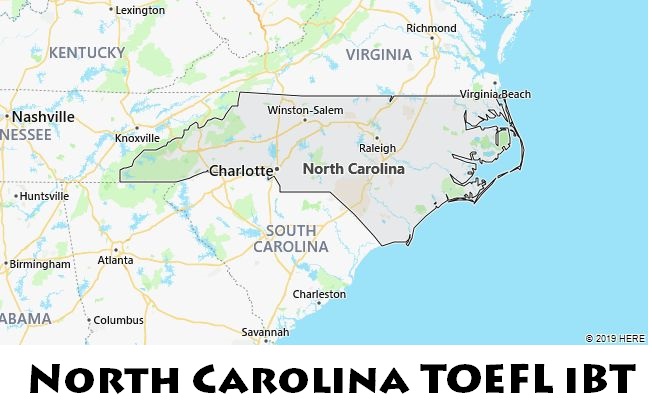
The TOEFL iBT test is offered in the state of North Carolina. The list below shows testing locations for computer based TOEFL exam. Please scroll down to find the most up-to-date list of available test centers (including addresses) in North Carolina.
- ETS – NC CENTRAL UNIVERSITY – APCN-7578
1801 Fayettville St., Taylor Education Bldg., Room 113,
Durham, North Carolina 27707 United States - Raleigh – Spring Forest Road – APCN-1602
3200 Spring Forest Road, Suite 212,
Raleigh, North Carolina 27616 United States - Raleigh – Spring Forest Road – APCN-0027
3200 Spring Forest Road, Suite 212,
Raleigh, North Carolina 27616 United States - Greensboro – Centerview Drive – APCN-0058
3 Centerview Drive, Suite 248,
Greensboro, North Carolina 27407 United States - Winston-Salem State University – STN11106A
601 Martin Luther King, Jr. Drive, Carolina Hall Room 224,
Winston-salem, North Carolina 27110 United States - UNC Pembroke – Office for Regional Initiatives – STN15539A
115 Livermore Drive,
Pembroke, North Carolina 28372 United States - Greenville – WH Smith Boulevard – APCN-1618
1011 W.h. Smith Blvd., Suite 102,
Greenville, North Carolina 27834 United States
North Carolina Area Codes
Short for NC, North Carolina was admitted to United States on 11/21/1789. The capital city is Charlotte. With an area of 139,389 km², North Carolina has a population of 10,146,788. The population density is 72.79 people per km².
North Carolina Overview
In the 1680s, the British tried to establish their first American colony on Roanoke Island in North Carolina, but this attempt was unsuccessful. The settlement was abandoned, the fate of the colonists is not known for certain, most likely they assimilated with the Indians who lived here. In the history of the United States, the Roanoke colony entered as “disappeared” or “lost”.
In the middle of the 17th century, colonists began to move to the territory of modern North Carolina from the north, from the colony of Virginia.; it was then that permanent European settlements appeared here. In 1663, King Charles II of England granted the rights to the new colony (named “Caroline” after his father, Charles I) to eight of his favorites, known as the “Lords Proprietors”. Due to geographical features (primarily due to the presence of convenient harbors), the southern part of Carolina developed faster; the provincial government was also located in Charleston. Less attention was paid to the northern districts (which even led to riots among the colonists) and gradually began to distinguish, albeit informally, North and South Carolina. Since 1712, North Carolina actually became an independent colony, and after the British crown bought their rights from seven lords in 1729, it received the status of a royal colony. In the middle of the 18th century, North Carolina was the fastest growing of all the English colonies in North America. Disagreements between sections of society and dissatisfaction with government officials led in 1768 to an uprising known as the Regulators’ War.
In the 1870s, the Sons of Liberty movement was gaining momentum in North Carolina, striving for independence. In 1775, the “committees of security” created on the recommendation of the First Continental Congress effectively replaced local governments, and the “Council of Security” approved by the Provincial Congress began to perform the functions of government. On April 12, 1776, North Carolina legislators passed the so-called “Halifax Resolutions,” which authorized delegates going to the Second Continental Congress to vote for the declaration of independence (this was the first such document in the colonies). During the American Revolutionary War, the population of North Carolina was divided into patriots and loyalists (adherents of the crown), which led to numerous clashes. Also in 1780–1781, several battles took place here between the Continental Army and British forces. On November 21, 1789, North Carolina ratified the Constitution of the United States of America, thus becoming the twelfth US state.
Now, about 900,000 people live in North Carolina’s largest city, Charlotte. The state capital, Raleigh, has about 475,000 residents. The state’s largest metropolitan area has grown up around Charlotte and is home to about 2,700,000 people.
The economy of modern North Carolina is well developed and very diverse. The state ranks among the top in the country in terms of production of tobacco and sweet potatoes (yam), as well as pigs, broilers and turkeys. The farms also grow soybeans, cotton, Christmas trees and other crops, and breed trout. Traditional industries (textile, tobacco, woodworking) are gradually giving way to more modern and high-tech industries (electronics, various equipment, food processing). The development of industry and the service sector is facilitated by the creation of the so-called “Research Triangle”, formed around the state’s leading universities.

